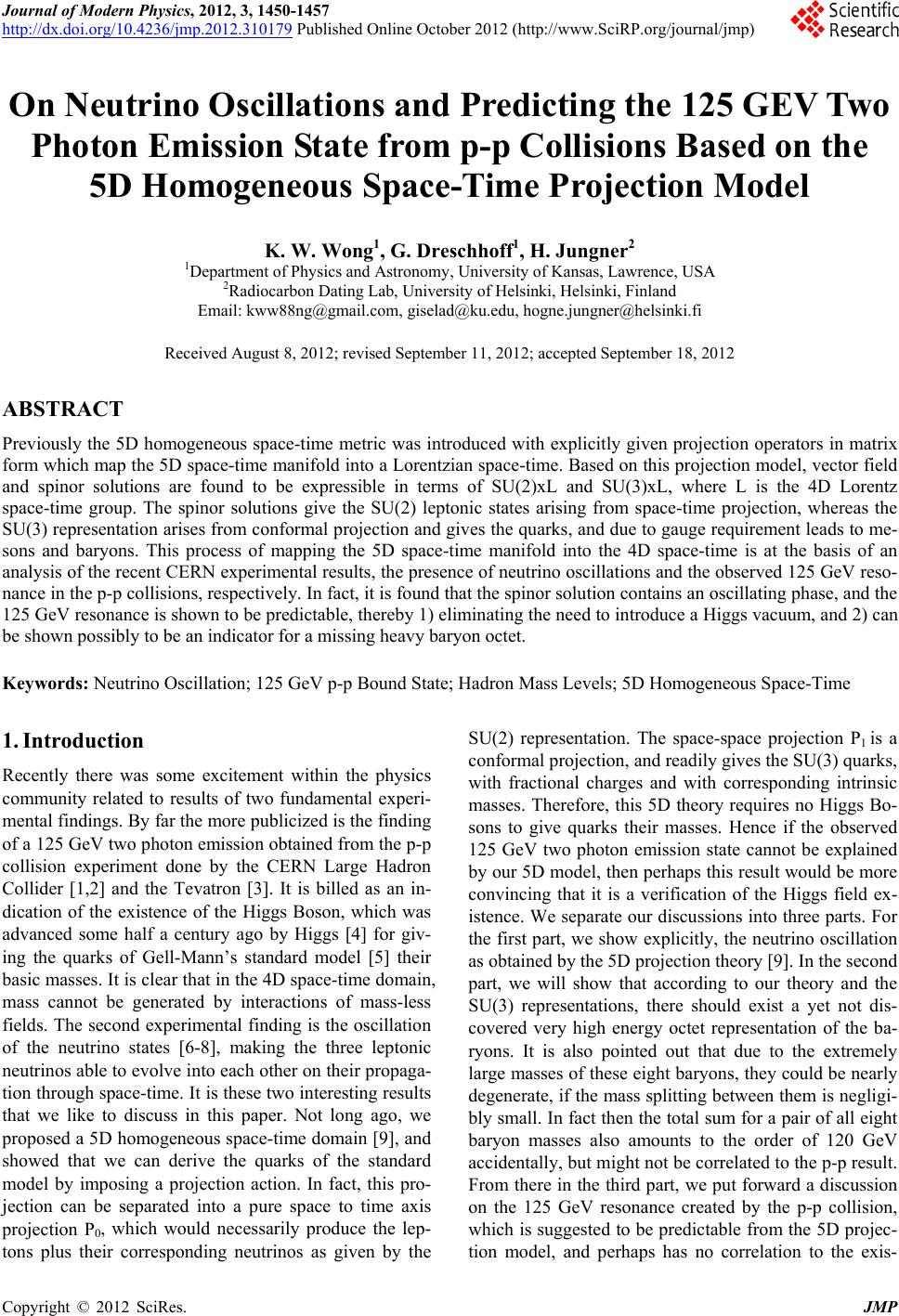 Journal of Modern Physics, 2012, 3, 1450-1457 http://dx.doi.org/10.4236/jmp.2012.310179 Published Online October 2012 (http://www.SciRP.org/journal/jmp) On Neutrino Oscillations and Predicting the 125 GEV Two Photon Emission State from p-p Collisions Based on the 5D Homogeneous Space-Time Projection Model K. W. Wong1, G. Dreschhoff1, H. Jungner2 1Department of Physics and Astronomy, University of Kansas, Lawrence, USA 2Radiocarbon Dating Lab, University of Helsinki, Helsinki, Finland Email: kww88ng@gmail.com, giselad@ku.edu, hogne.jungner@helsinki.fi Received August 8, 2012; revised September 11, 2012; accepted September 18, 2012 ABSTRACT Previously the 5D homogeneous space-time metric was introduced with explicitly given projection operators in matrix form which map the 5D space-time manifold into a Lorentzian space-time. Based on this projection model, vector field and spinor solutions are found to be expressible in terms of SU(2)xL and SU(3)xL, where L is the 4D Lorentz space-time group. The spinor solutions give the SU(2) leptonic states arising from space-time projection, whereas the SU(3) representation arises from conformal projection and gives the quarks, and due to gauge requirement leads to me- sons and baryons. This process of mapping the 5D space-time manifold into the 4D space-time is at the basis of an analysis of the recent CERN experimental results, the presence of neutrino oscillations and the observed 125 GeV reso- nance in the p-p collisions, respectively. In fact, it is found that the spinor solution contains an oscillating phase, and the 125 GeV resonance is shown to be predictable, thereby 1) eliminating the need to introduce a Higgs vacuum, and 2) can be shown possibly to be an indicator for a missing heavy baryon octet. Keywords: Neutrino Oscillation; 125 GeV p-p Bound State; Hadron Mass Levels; 5D Homogeneous Space-Time 1. Introduction Recently there was some excitement within the physics community related to results of two fundamental experi- mental findings. By far the more publicized is the finding of a 125 GeV two photon emission obtained from the p-p collision experiment done by the CERN Large Hadron Collider [1,2] and the Tevatron [3]. It is billed as an in- dication of the existence of the Higgs Boson, which was advanced some half a century ago by Higgs [4] for giv- ing the quarks of Gell-Mann’s standard model [5] their basic masses. It is clear that in the 4D space-time domain, mass cannot be generated by interactions of mass-less fields. The second experimental finding is the oscillation of the neutrino states [6-8], making the three leptonic neutrinos able to evolve into each other on their propaga- tion through space-time. It is these two interesting results that we like to discuss in this paper. Not long ago, we proposed a 5D homogeneous space-time domain [9], and showed that we can derive the quarks of the standard model by imposing a projection action. In fact, this pro- jection can be separated into a pure space to time axis projection P0, which would necessarily produce the lep- tons plus their corresponding neutrinos as given by the SU(2) representation. The space-space projection P1 is a conformal projection, and readily gives the SU(3) quarks, with fractional charges and with corresponding intrinsic masses. Therefore, this 5D theory requires no Higgs Bo- sons to give quarks their masses. Hence if the observed 125 GeV two photon emission state cannot be explained by our 5D model, then perhaps this result would be more convincing that it is a verification of the Higgs field ex- istence. We separate our discussions into three parts. For the first part, we show explicitly, the neutrino oscillation as obtained by the 5D projection theory [9]. In the second part, we will show that according to our theory and the SU(3) representations, there should exist a yet not dis- covered very high energy octet representation of the ba- ryons. It is also pointed out that due to the extremely large masses of these eight baryons, they could be nearly degenerate, if the mass splitting between them is negligi- bly small. In fact then the total sum for a pair of all eight baryon masses also amounts to the order of 120 GeV accidentally, but might not be correlated to the p-p result. From there in the third part, we put forward a discussion on the 125 GeV resonance created by the p-p collision, which is suggested to be predictable from the 5D projec- tion model, and perhaps has no correlation to the exis- C opyright © 2012 SciRes. JMP 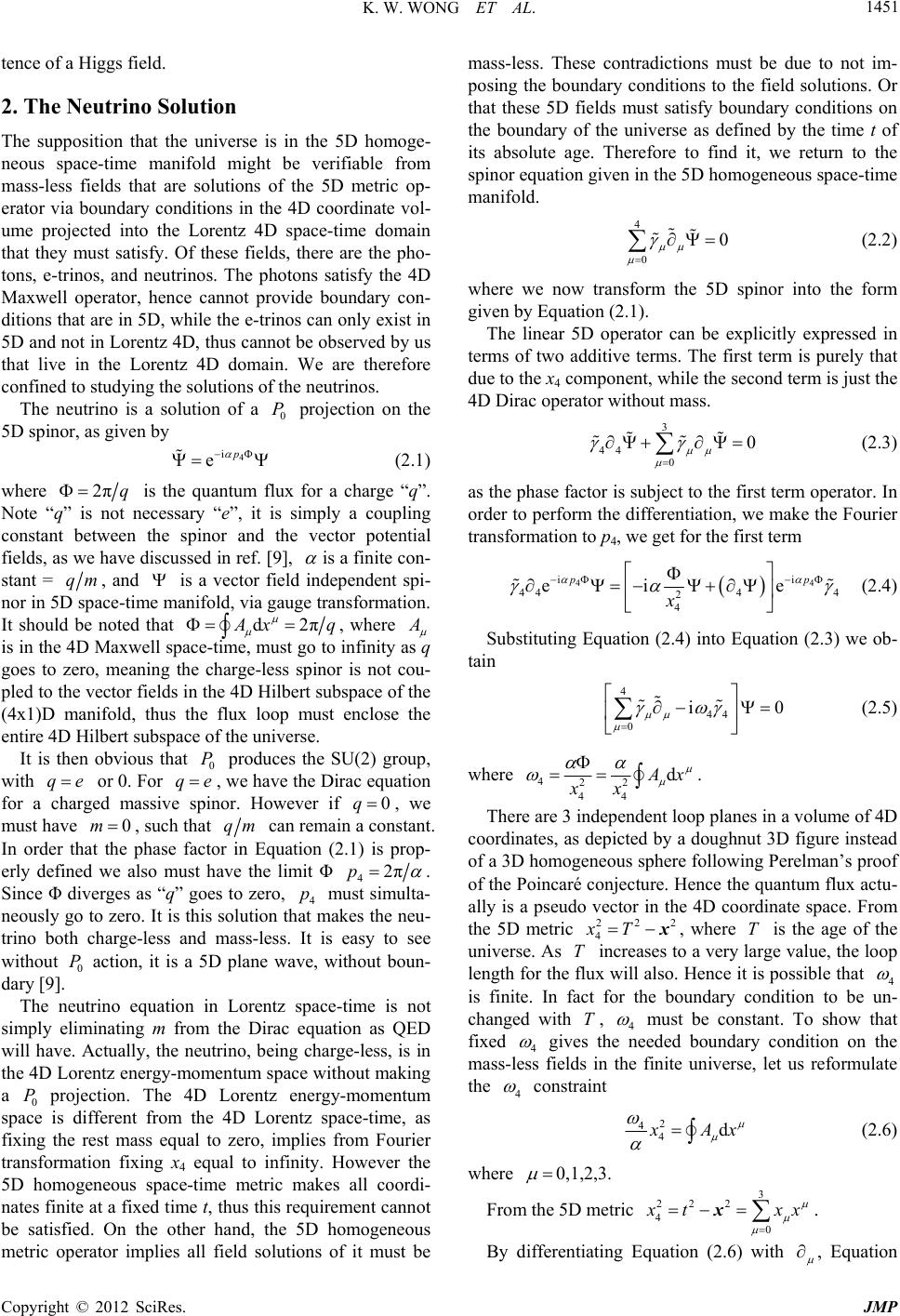 K. W. WONG ET AL. 1451 tence of a Higgs field. 2. The Neutrino Solution The supposition that the universe is in the 5D homoge- neous space-time manifold might be verifiable from mass-less fields that are solutions of the 5D metric op- erator via boundary conditions in the 4D coordinate vol- ume projected into the Lorentz 4D space-time domain that they must satisfy. Of these fields, there are the pho- tons, e-trinos, and neutrinos. The photons satisfy the 4D Maxwell operator, hence cannot provide boundary con- ditions that are in 5D, while the e-trinos can only exist in 5D and not in Lorentz 4D, thus cannot be observed by us that live in the Lorentz 4D domain. We are therefore confined to studying the solutions of the neutrinos. The neutrino is a solution of a projection on the 5D spinor, as given by 0 P 4 i ep (2.1) where 2πq is the quantum flux for a charge “q”. Note “q” is not necessary “e”, it is simply a coupling constant between the spinor and the vector potential fields, as we have discussed in ref. [9], is a finite con- stant = qm , and is a vector field independent spi- nor in 5D space-time manifold, via gauge transformation. It should be noted that d2π xq , where is in the 4D Maxwell space-time, must go to infinity as q goes to zero, meaning the charge-less spinor is not cou- pled to the vector fields in the 4D Hilbert subspace of the (4x1)D manifold, thus the flux loop must enclose the entire 4D Hilbert subspace of the universe. It is then obvious that produces the SU(2) group, with or 0. For , we have the Dirac equation for a charged massive spinor. However if q 0 P qe 0 qe , we must have , such that 0mqm can remain a constant. In order that the phase factor in Equation (2.1) is prop- erly defined we also must have the limit Φ 42πp . Since Φ diverges as “q” goes to zero, 4 must simulta- neously go to zero. It is this solution that makes the neu- trino both charge-less and mass-less. It is easy to see without 0 action, it is a 5D plane wave, without boun- dary [9]. p P The neutrino equation in Lorentz space-time is not simply eliminating m from the Dirac equation as QED will have. Actually, the neutrino, being charge-less, is in the 4D Lorentz energy-momentum space without making a 0 projection. The 4D Lorentz energy-momentum space is different from the 4D Lorentz space-time, as fixing the rest mass equal to zero, implies from Fourier transformation fixing x4 equal to infinity. However the 5D homogeneous space-time metric makes all coordi- nates finite at a fixed time t, thus this requirement cannot be satisfied. On the other hand, the 5D homogeneous metric operator implies all field solutions of it must be mass-less. These contradictions must be due to not im- posing the boundary conditions to the field solutions. Or that these 5D fields must satisfy boundary conditions on the boundary of the universe as defined by the time t of its absolute age. Therefore to find it, we return to the spinor equation given in the 5D homogeneous space-time manifold. P 4 0 0 3 44 0 0 (2.2) where we now transform the 5D spinor into the form given by Equation (2.1). The linear 5D operator can be explicitly expressed in terms of two additive terms. The first term is purely that due to the x4 component, while the second term is just the 4D Dirac operator without mass. (2.3) as the phase factor is subject to the first term operator. In order to perform the differentiation, we make the Fourier transformation to p4, we get for the first term 44 ii 444 4 2 4 ei e pp x 4 44 0 i0 (2.4) Substituting Equation (2.4) into Equation (2.3) we ob- tain (2.5) where 422 44 d x xx 222 xT . There are 3 independent loop planes in a volume of 4D coordinates, as depicted by a doughnut 3D figure instead of a 3D homogeneous sphere following Perelman’s proof of the Poincaré conjecture. Hence the quantum flux actu- ally is a pseudo vector in the 4D coordinate space. From the 5D metric 4 xT T , where is the age of the universe. As increases to a very large value, the loop length for the flux will also. Hence it is possible that 4 is finite. In fact for the boundary condition to be un- changed with , 4 T must be constant. To show that fixed 4 gives the needed boundary condition on the mass-less fields in the finite universe, let us reformulate the 4 constraint 2 4 4d Ax (2.6) where 0,1,2,3. 3 22 2 4 0 From the 5D metric txx x. By differentiating Equation (2.6) with , Equation Copyright © 2012 SciRes. JMP 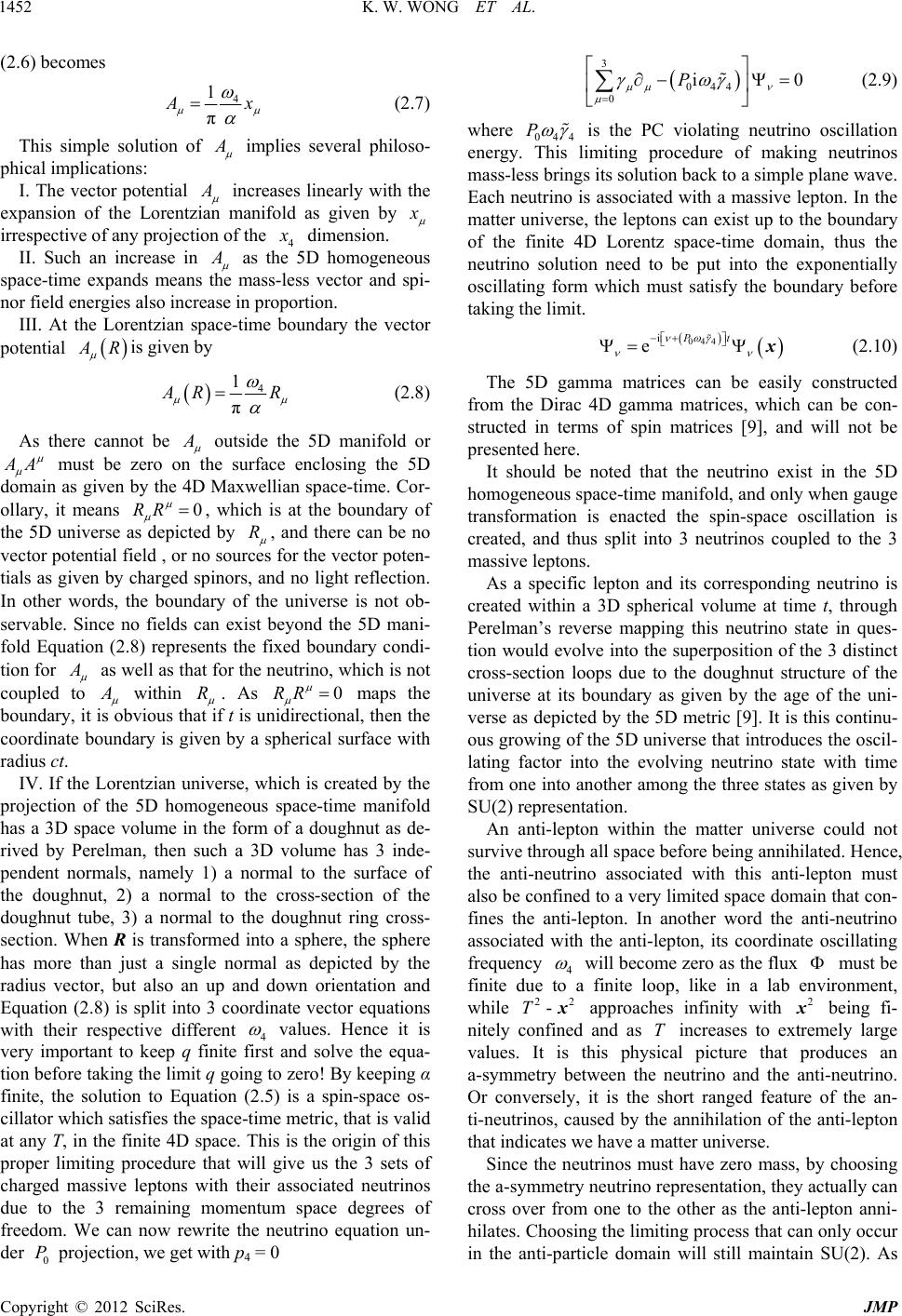 K. W. WONG ET AL. 1452 (2.6) becomes 4 1 π x (2.7) This simple solution of implies several philoso- phical implications: I. The vector potential increases linearly with the expansion of the Lorentzian manifold as given by irrespective of any projection of the 4 dimension. II. Such an increase in as the 5D homogeneous space-time expands means the mass-less vector and spi- nor field energies also increase in proportion. III. At the Lorentzian space-time boundary the vector potential R is given by 4 1 π RR (2.8) As there cannot be outside the 5D manifold or A 0RR R must be zero on the surface enclosing the 5D domain as given by the 4D Maxwellian space-time. Cor- ollary, it means , which is at the boundary of the 5D universe as depicted by , and there can be no vector potential field , or no sources for the vector poten- tials as given by charged spinors, and no light reflection. In other words, the boundary of the universe is not ob- servable. Since no fields can exist beyond the 5D mani- fold Equation (2.8) represents the fixed boundary condi- tion for as well as that for the neutrino, which is not coupled to within R . As maps the boundary, it is obvious that if t is unidirectional, then the coordinate boundary is given by a spherical surface with radius ct. 0RR IV. If the Lorentzian universe, which is created by the projection of the 5D homogeneous space-time manifold has a 3D space volume in the form of a doughnut as de- rived by Perelman, then such a 3D volume has 3 inde- pendent normals, namely 1) a normal to the surface of the doughnut, 2) a normal to the cross-section of the doughnut tube, 3) a normal to the doughnut ring cross- section. When R is transformed into a sphere, the sphere has more than just a single normal as depicted by the radius vector, but also an up and down orientation and Equation (2.8) is split into 3 coordinate vector equations with their respective different 4 values. Hence it is very important to keep q finite first and solve the equa- tion before taking the limit q going to zero! By keeping α finite, the solution to Equation (2.5) is a spin-space os- cillator which satisfies the space-time metric, that is valid at any T, in the finite 4D space. This is the origin of this proper limiting procedure that will give us the 3 sets of charged massive leptons with their associated neutrinos due to the 3 remaining momentum space degrees of freedom. We can now rewrite the neutrino equation un- 3 der 0 P projectionet with p4 = 0 044 0 i0P , we g (2.9) where 044 P is the PC violating neutrino oscillation his 044 i ePt x (2.10) The 5D gamma matrices can be eas fr energy. Tlimiting procedure of making neutrinos mass-less brings its solution back to a simple plane wave. Each neutrino is associated with a massive lepton. In the matter universe, the leptons can exist up to the boundary of the finite 4D Lorentz space-time domain, thus the neutrino solution need to be put into the exponentially oscillating form which must satisfy the boundary before taking the limit. ily constructed om the Dirac 4D gamma matrices, which can be con- structed in terms of spin matrices [9], and will not be presented here. It should be noted that the neutrino exist in the 5D homogeneous space-time manifold, and only when gauge transformation is enacted the spin-space oscillation is created, and thus split into 3 neutrinos coupled to the 3 massive leptons. As a specific lepton and its corresponding neutrino is created within a 3D spherical volume at time t, through Perelman’s reverse mapping this neutrino state in ques- tion would evolve into the superposition of the 3 distinct cross-section loops due to the doughnut structure of the universe at its boundary as given by the age of the uni- verse as depicted by the 5D metric [9]. It is this continu- ous growing of the 5D universe that introduces the oscil- lating factor into the evolving neutrino state with time from one into another among the three states as given by SU(2) representation. An anti-lepton within the matter universe could not survive through all space before being annihilated. Hence, the anti-neutrino associated with this anti-lepton must also be confined to a very limited space domain that con- fines the anti-lepton. In another word the anti-neutrino associated with the anti-lepton, its coordinate oscillating frequency 4 will become zero as the flux must be finite due to a finite loop, like in a lab eironment, while 2 T-2 x approaches infinity with 2 x being fi- nitely cfin and as T increases to exmely large values. It is this physical picture that produces an a-symmetry between the neutrino and the anti-neutrino. Or conversely, it is the short ranged feature of the an- ti-neutrinos, caused by the annihilation of the anti-lepton that indicates we have a matter universe. Since the neutrinos must have zero mass, by choosing th nv on edtre e a-symmetry neutrino representation, they actually can cross over from one to the other as the anti-lepton anni- hilates. Choosing the limiting process that can only occur in the anti-particle domain will still maintain SU(2). As Copyright © 2012 SciRes. JMP 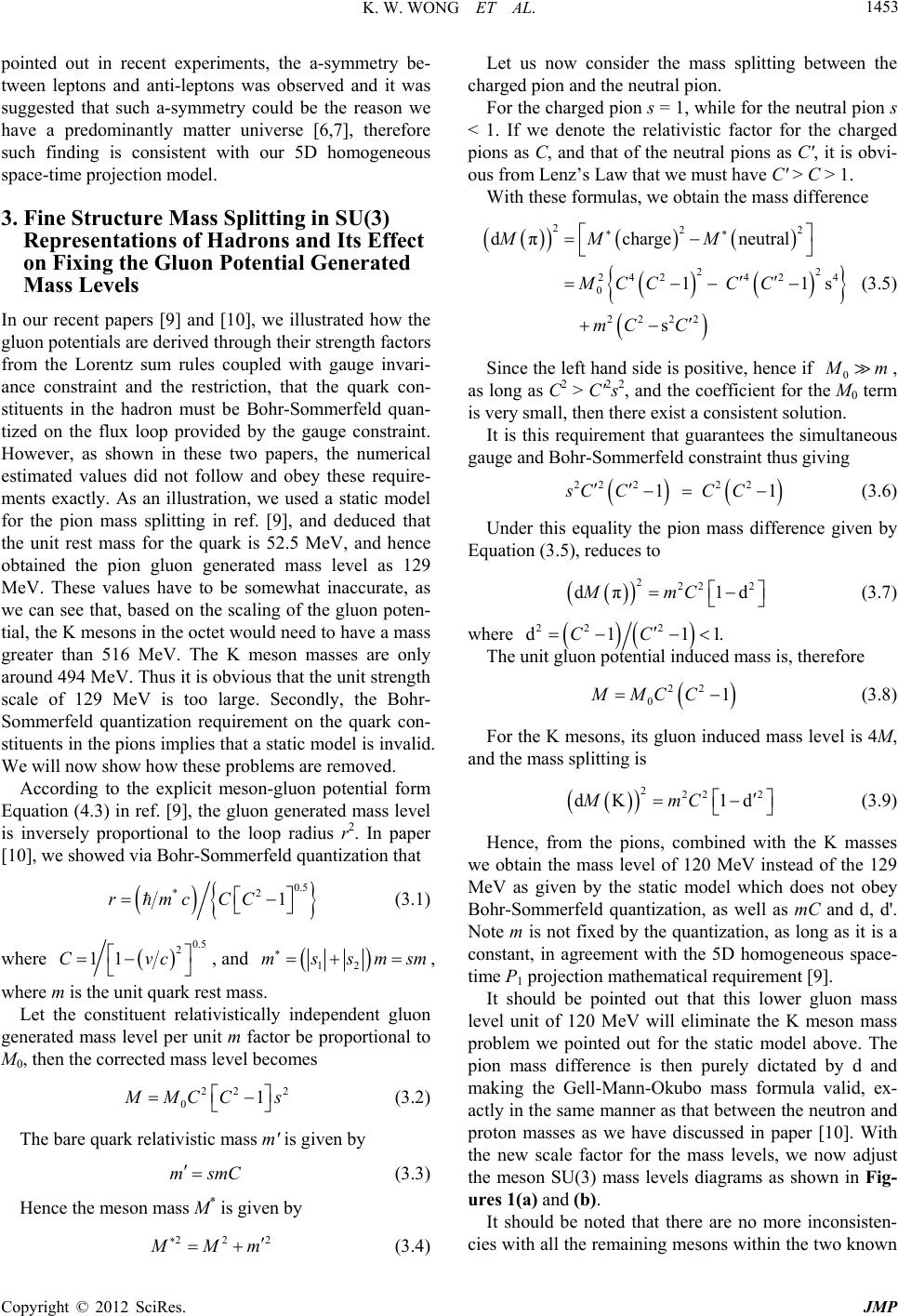 K. W. WONG ET AL. 1453 pointed out in recent experiments, the a-symmetry be- tween leptons and anti-leptons was observed and it was suggested that such a-symmetry could be the reason we have a predominantly matter universe [6,7], therefore such finding is consistent with our 5D homogeneous space-time projection model. 3. Fine Structure Mass Splitting in SU(3) Representations of Hadrons a nd I ts E ff ec t d Ine gluved through their strength factors vel is on Fixing the Gluon Potential Generate Mass Levels our recent papers [9] and [10], we illustrated how th on potentials are deri from the Lorentz sum rules coupled with gauge invari- ance constraint and the restriction, that the quark con- stituents in the hadron must be Bohr-Sommerfeld quan- tized on the flux loop provided by the gauge constraint. However, as shown in these two papers, the numerical estimated values did not follow and obey these require- ments exactly. As an illustration, we used a static model for the pion mass splitting in ref. [9], and deduced that the unit rest mass for the quark is 52.5 MeV, and hence obtained the pion gluon generated mass level as 129 MeV. These values have to be somewhat inaccurate, as we can see that, based on the scaling of the gluon poten- tial, the K mesons in the octet would need to have a mass greater than 516 MeV. The K meson masses are only around 494 MeV. Thus it is obvious that the unit strength scale of 129 MeV is too large. Secondly, the Bohr- Sommerfeld quantization requirement on the quark con- stituents in the pions implies that a static model is invalid. We will now show how these problems are removed. According to the explicit meson-gluon potential form Equation (4.3) in ref. [9], the gluon generated mass le inversely proportional to the loop radius r2. In paper [10], we showed via Bohr-Sommerfeld quantization that 0.5 21rmcCC (3.1) where 0.5 2 11Cvc , and 12 ms is the unit quark rest mass. he constituent relativistically indep generated mass level p the corrected mass level becomes smsm, where m Let tendent gluon er unit m factor be proportional to M0, then 22 2 01 MC Cs (3.2) The bare quark relativistic mass m' is given by msmC * 222 (3.3) Hence the meson mass M is given by Mm (3.4) Let us now consider the ma ch e neutral pion s < 1. If we denote the relativistic f pi 2222 smC C .5) Since the left hand side is positive, hence if 0 ss splitting between the arged pion and the neutral pion. For the charged pion s = 1, while for th actor for the charged ons as C, and that of the neutral pions as C', it is obvi- ous from Lenz’s Law that we must have C' > C > 1. With these formulas, we obtain the mass difference 222 22 2424 24 dπcharge neutralMM M 01 1 sMCC CC (3 m, 0 term as long as C2 > C'2s2, and the coefficient for the M is very small, then there exist a consistent solution. It is this requirement that guarantees the simultaneous gang uge and Bohr-Sommerfeld constraint thus givi 2222 2 1 1sCCC C (3.6) Under this equality the pion mass difference given by Equation (3.5), reduces to 222 2 dπ1dMmC (3.7) where 22 2 d111.CC The unit gluon potential induced mass is, therefore 22 01MMCC M, an 222 dK 1MmC f 120 MeV instead of the 129 MeV as given by the static model whic Bohr-Sommerfeld quantization, as well N (3.8) For tuhe K mesons, its gluon indced mass level is 4 d the mass splitting is 2 d (3.9) Hence, from the pions, combined with the K masses we obtain the mass level o h does not obey as mC and d, d'. ote m is not fixed by the quantization, as long as it is a constant, in agreement with the 5D homogeneous space- time P1 projection mathematical requirement [9]. It should be pointed out that this lower gluon mass level unit of 120 MeV will eliminate the K meson mass problem we pointed out for the static model above. The pion mass difference is then purely dictated by d and making the Gell-Mann-Okubo mass formula valid, ex- actly in the same manner as that between the neutron and proton masses as we have discussed in paper [10]. With the new scale factor for the mass levels, we now adjust the meson SU(3) mass levels diagrams as shown in Fig- ures 1(a) and (b). It should be noted that there are no more inconsisten- cies with all the remaining mesons within the two known Copyright © 2012 SciRes. JMP 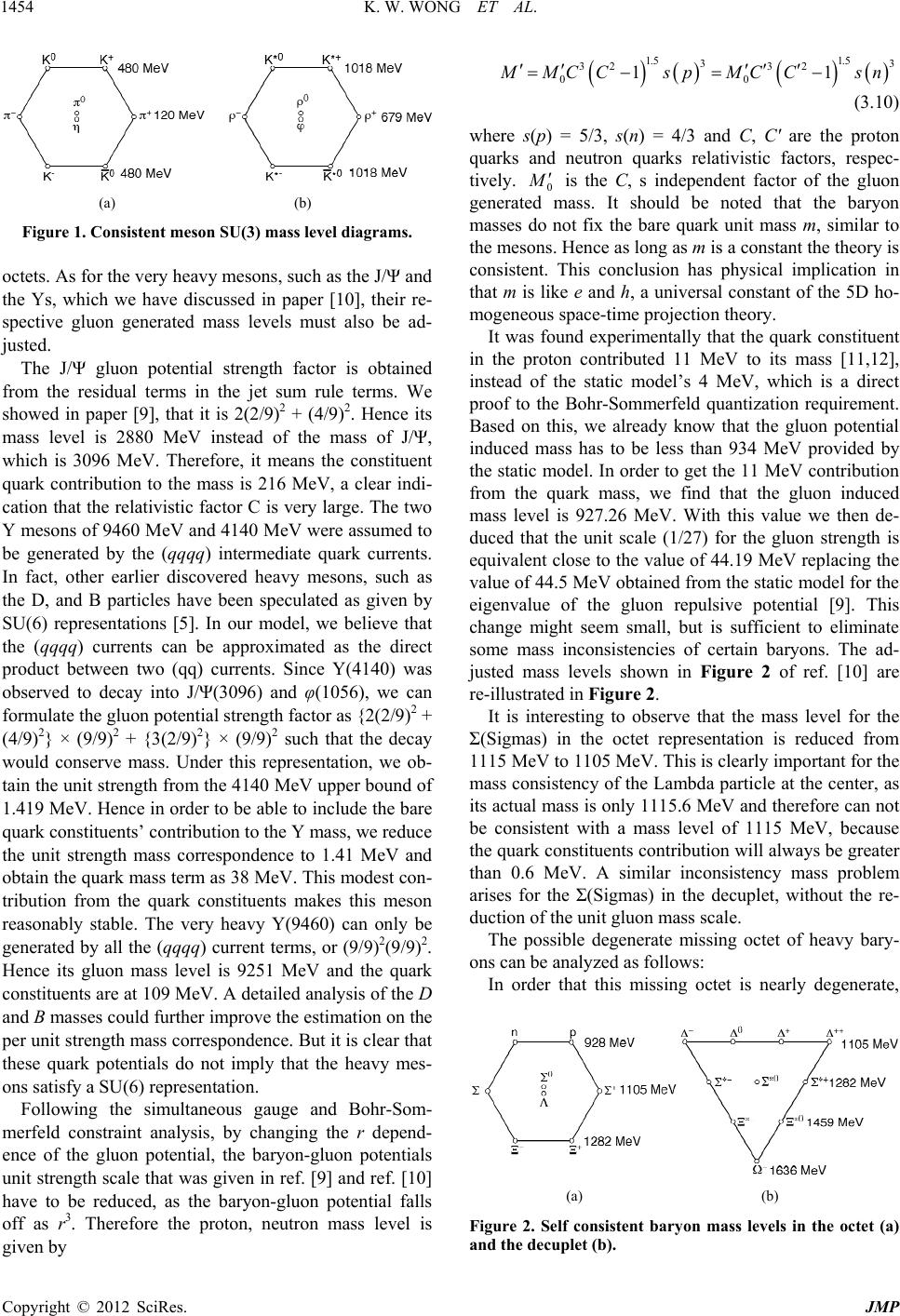 K. W. WONG ET AL. 1454 (a) (b) Figure 1. Consistent meson SU(3) mass level diagrams. octets. As for the very heavy mesons, such as the J/Ψ and the Ys, whic [10], their re- sp - sted. vel is 2880 MeV instead of the mass of J/Ψ, w ref. [9] and ref. [10] ha h we have discussed in paper ective gluon generated mass levels must also be ad ju The J/Ψ gluon potential strength factor is obtained from the residual terms in the jet sum rule terms. We showed in paper [9], that it is 2(2/9)2 + (4/9)2. Hence its mass le hich is 3096 MeV. Therefore, it means the constituent quark contribution to the mass is 216 MeV, a clear indi- cation that the relativistic factor C is very large. The two Y mesons of 9460 MeV and 4140 MeV were assumed to be generated by the (qqqq) intermediate quark currents. In fact, other earlier discovered heavy mesons, such as the D, and B particles have been speculated as given by SU(6) representations [5]. In our model, we believe that the (qqqq) currents can be approximated as the direct product between two (qq) currents. Since Y(4140) was observed to decay into J/Ψ(3096) and φ(1056), we can formulate the gluon potential strength factor as {2(2/9)2 + (4/9)2} × (9/9)2 + {3(2/9)2} × (9/9)2 such that the decay would conserve mass. Under this representation, we ob- tain the unit strength from the 4140 MeV upper bound of 1.419 MeV. Hence in order to be able to include the bare quark constituents’ contribution to the Y mass, we reduce the unit strength mass correspondence to 1.41 MeV and obtain the quark mass term as 38 MeV. This modest con- tribution from the quark constituents makes this meson reasonably stable. The very heavy Y(9460) can only be generated by all the (qqqq) current terms, or (9/9)2(9/9)2. Hence its gluon mass level is 9251 MeV and the quark constituents are at 109 MeV. A detailed analysis of the D and B masses could further improve the estimation on the per unit strength mass correspondence. But it is clear that these quark potentials do not imply that the heavy mes- ons satisfy a SU(6) representation. Following the simultaneous gauge and Bohr-Som- merfeld constraint analysis, by changing the r depend- ence of the gluon potential, the baryon-gluon potentials unit strength scale that was given in ve to be reduced, as the baryon-gluon potential falls off as r3. Therefore the proton, neutron mass level is given by 1.5 1.5 33 323 2 00 11 MCCspMCCs n (3.10) where s(p) = 5/3, s(n) = 4/3 and C, C' are the proton quarks and neutron quarks relativistic factors, respec tively. 0 - is the C, s independent factor of the glu generated mass. It should be noted that the b n requirement. B mbda particle at the center, as its on aryon masses do not fix the bare quark unit mass m, similar to the mesons. Hence as long as m is a constant the theory is consistent. This conclusion has physical implication in that m is like e and h, a universal constant of the 5D ho- mogeneous space-time projection theory. It was found experimentally that the quark constituent in the proton contributed 11 MeV to its mass [11,12], instead of the static model’s 4 MeV, which is a direct proof to the Bohr-Sommerfeld quantizatio ased on this, we already know that the gluon potential induced mass has to be less than 934 MeV provided by the static model. In order to get the 11 MeV contribution from the quark mass, we find that the gluon induced mass level is 927.26 MeV. With this value we then de- duced that the unit scale (1/27) for the gluon strength is equivalent close to the value of 44.19 MeV replacing the value of 44.5 MeV obtained from the static model for the eigenvalue of the gluon repulsive potential [9]. This change might seem small, but is sufficient to eliminate some mass inconsistencies of certain baryons. The ad- justed mass levels shown in Figure 2 of ref. [10] are re-illustrated in Figure 2. It is interesting to observe that the mass level for the Σ(Sigmas) in the octet representation is reduced from 1115 MeV to 1105 MeV. This is clearly important for the mass consistency of the La actual mass is only 1115.6 MeV and therefore can not be consistent with a mass level of 1115 MeV, because the quark constituents contribution will always be greater than 0.6 MeV. A similar inconsistency mass problem arises for the Σ(Sigmas) in the decuplet, without the re- duction of the unit gluon mass scale. The possible degenerate missing octet of heavy bary- ons can be analyzed as follows: In order that this missing octet is nearly degenerate, (a) (b) Figure 2. Self consistent baryon mass levels in the octet (a) and the decuplet (b). Copyright © 2012 SciRes. JMP 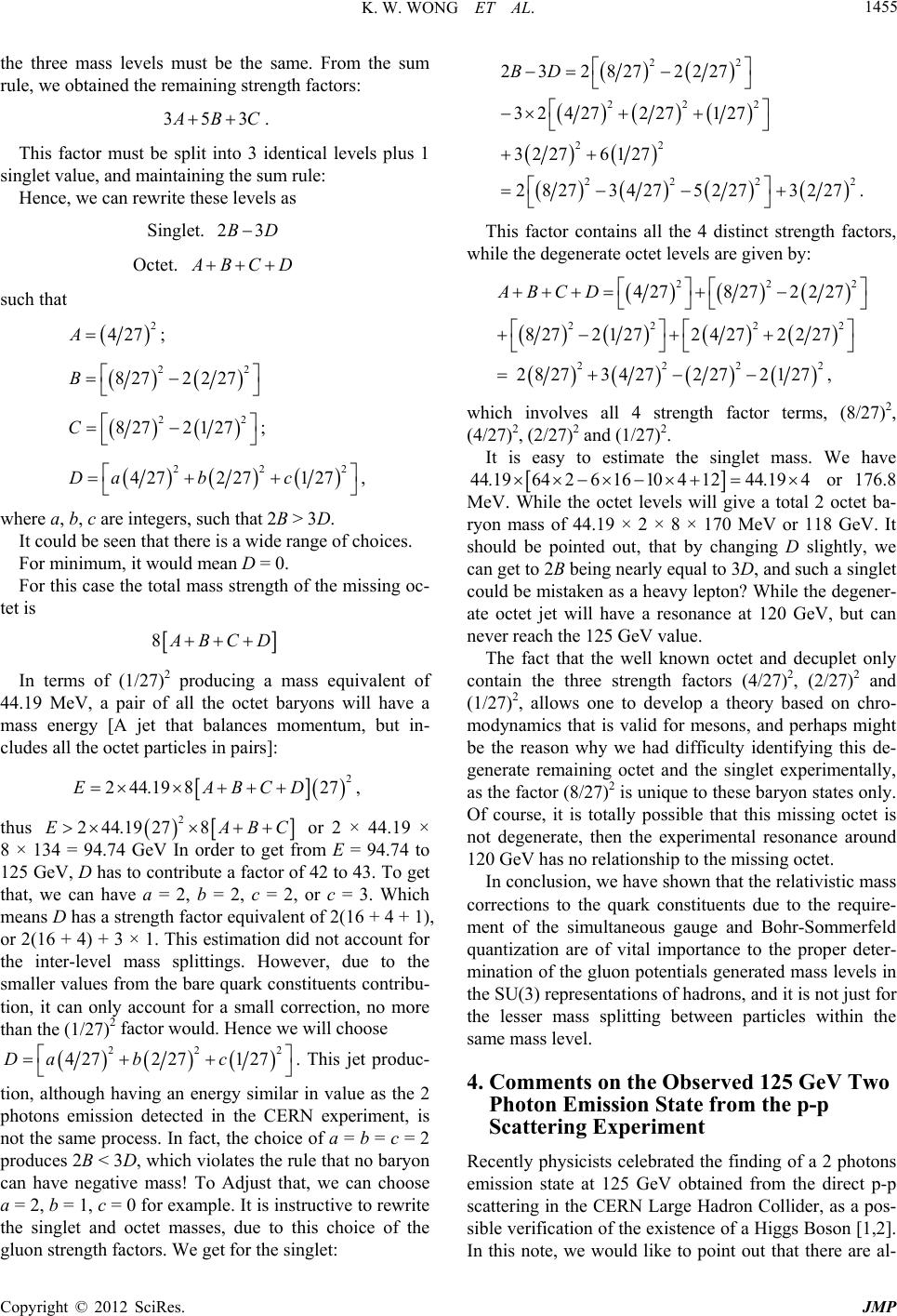 K. W. WONG ET AL. 1455 the three mass levels must be the same. From the sum rule, we obtained the remaining strength factors: 353 BC. This factor must be split into 3 identical levels plus 1 singlet value, and maintaining the sum rule: Hence, we can rewrite these levels as Singlet. 23BD Octet. BCD such that 2 427A; 8272227B 22 827 2127C ; 22 22 4227 127Dabc , where a, b, c are integers, such that 2B > 3D. e seen that there is a wide range of choices. For minimum, it w mean D = 0. For this case the total mass strength of the missing oc- tet is 2 27 It could b oul d 8 BCD producing a mass equivalent of 44.19 MeV, a pair of all the octet baryons will have a mass energy [A jet that balances momentumbut in- der to get from E = 94.74 to ute a facto 42 to 43. To get that, we can have a = 2, b = 2, c = 2, or c = 3. Which m stituents contribu- tion, it can only account for a small correction, no more than the (1/27)2 factor would. Hence we will choose In terms of (1/27)2 , cludes all the octet particles in pairs]: 2 27 , 244.198EABCD thus 2 244.19278EABC or 2 × 44.19 × 8 × 134 = 94.74 GeV In or 125 GeV, D has to contribr of eans D has a strength factor equivalent of 2(16 + 4 + 1), or 2(16 + 4) + 3 × 1. This estimation did not account for the inter-level mass splittings. However, due to the smaller values from the bare quark con 222 427227 127abc D . This jet produc- tion, although having an energy similar in value as the 2 photons emission detected in the CERN experiment, is not the same process. In fact, the choice of a = b = c = 2 produces 2B < 3D, which violates the rule that no baryon can have negative mass! To Adjust that, we can choose a = 2, b = 1, c = 0 for example. It is instructive to rewrite the singlet and octet masses, due to this choice of the gluon strength factors. We get for the singlet: 22 222 2 32 427227127 32 276 127 282734 2752 2732 27. This factor contains all the 4 distinct strength factors, while the degenerate octet levels are given by: 22 23282722 27BD 22 2 2 2222 2222 27 82721272 4272227 282734272272127, 22 4 278 2722ABCD which involves all 4 strength factor terms, (8/27)2, (4/27)2, (2/27)2 and (1/27)2. It is easy to estimate the singlet mass. We have 44.19 6426161041244.194 or 176.8 MeV. While the octet levels will give a total 2 octet ba- ryon mass of 44.19 × 2 × 8 × 170 MeV or 118 GeV. It should be pointed out, that by changing D slightly, we can get to 2B being nearly equal to 3D, and such a singlet could be mistaken as a heavy lepton? While the dege ate octet jet will have a resonance at 120 GeV, but can never reach the 125 GeV value. d modynamics that is valid for mesons, and per ner- The fact that the well known octet and decuplet only contain the three strength factors (4/27)2, (2/27)2 an (1/ 2 27) , allows one to develop a theory based on chro- haps might be the reason why we had difficulty identifying this de- generate remaining octet and the singlet experimentally, as the factor (8/27)2 is unique to these baryon states only. Of course, it is totally possible that this missing octet is not degenerate, then the experimental resonance around 120 GeV has no relationship to the missing octet. In conclusion, we have shown that the relativistic mass corrections to the quark constituents due to the require- ment of the simultaneous gauge and Bohr-Sommerfeld quantization are of vital importance to the proper deter- mination of the gluon potentials generated mass levels in the SU(3) representations of hadrons, and it is not just for the lesser mass splitting between particles within the same mass level. 4. Comments on the Observed 125 GeV Two Photon Emission State from the p-p Scattering Experiment Recently physicists celebrated the finding of a 2 photons emission state at 125 GeV obtained from the direct p-p scattering in the CERN Large Hadron Collider, as a pos- sible verification of the existence of a Higgs Boson [1,2]. In this note, we would like to point out that there are al- Copyright © 2012 SciRes. JMP 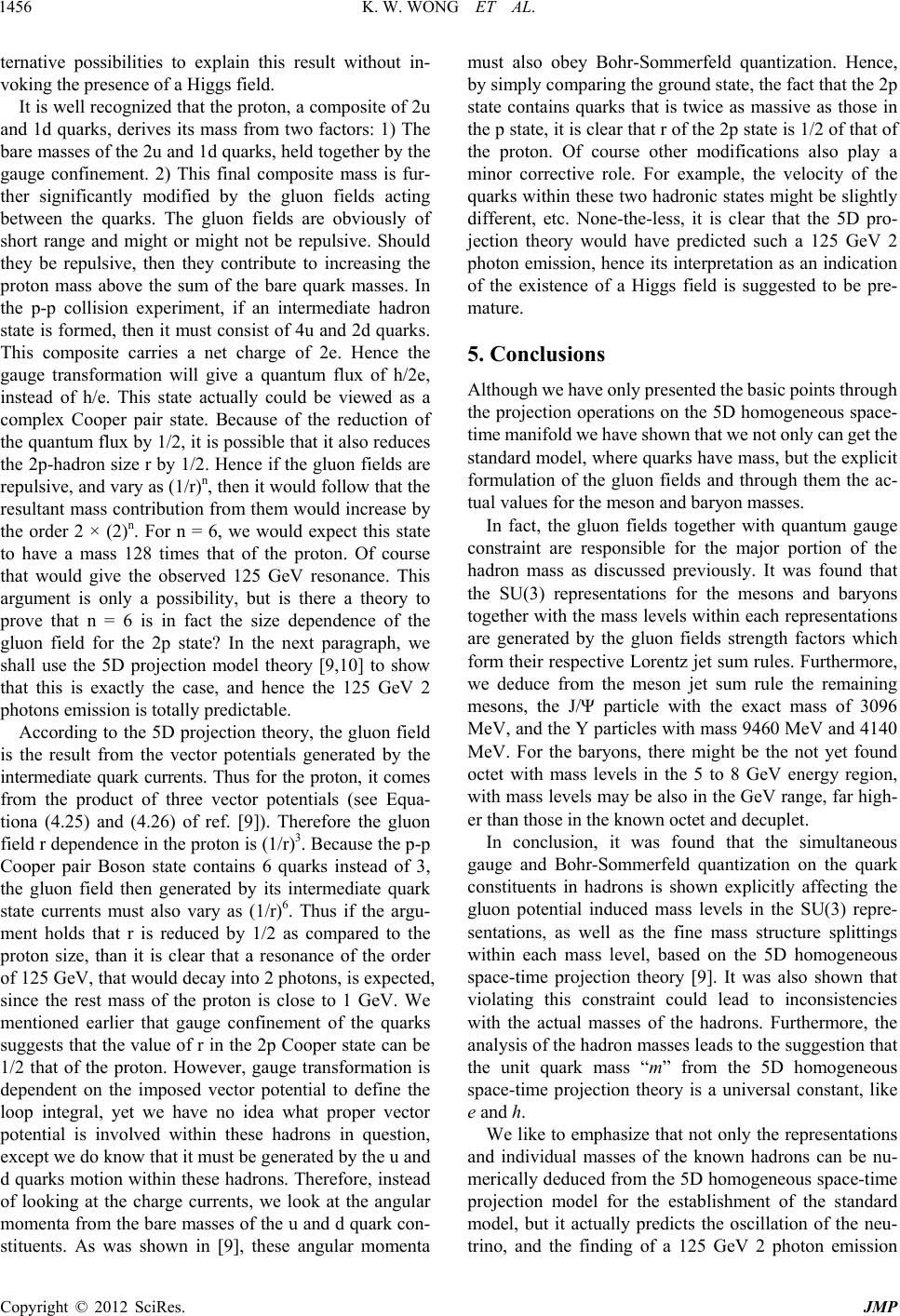 K. W. WONG ET AL. 1456 ternative possibilities to explain this result without in- voking the presence of a Higgs field. It is well recognized that the proton, a composite of 2u ba the ga composite mass is fur- ass as discussed previously. It was found that the SU(3) representations for the mesons and baryons ass levels within each representations e gluon fields strength factors which rgy region, w stant, like e and 1d quarks, derives its mass from two factors: 1) The re masses of the 2u and 1d quarks, held together by uge confinement. 2) This final ther significantly modified by the gluon fields acting between the quarks. The gluon fields are obviously of short range and might or might not be repulsive. Should they be repulsive, then they contribute to increasing the proton mass above the sum of the bare quark masses. In the p-p collision experiment, if an intermediate hadron state is formed, then it must consist of 4u and 2d quarks. This composite carries a net charge of 2e. Hence the gauge transformation will give a quantum flux of h/2e, instead of h/e. This state actually could be viewed as a complex Cooper pair state. Because of the reduction of the quantum flux by 1/2, it is possible that it also reduces the 2p-hadron size r by 1/2. Hence if the gluon fields are repulsive, and vary as (1/r)n, then it would follow that the resultant mass contribution from them would increase by the order 2 × (2)n. For n = 6, we would expect this state to have a mass 128 times that of the proton. Of course that would give the observed 125 GeV resonance. This argument is only a possibility, but is there a theory to prove that n = 6 is in fact the size dependence of the gluon field for the 2p state? In the next paragraph, we shall use the 5D projection model theory [9,10] to show that this is exactly the case, and hence the 125 GeV 2 photons emission is totally predictable. According to the 5D projection theory, the gluon field is the result from the vector potentials generated by the intermediate quark currents. Thus for the proton, it comes from the product of three vector potentials (see Equa- tiona (4.25) and (4.26) of ref. [9]). Therefore the gluon field r dependence in the proton is (1/r)3. Because the p-p Cooper pair Boson state contains 6 quarks instead of 3, the gluon field then generated by its intermediate quark state currents must also vary as (1/r)6. Thus if the argu- ment holds that r is reduced by 1/2 as compared to the proton size, than it is clear that a resonance of the order of 125 GeV, that would decay into 2 photons, is expected, since the rest mass of the proton is close to 1 GeV. We mentioned earlier that gauge confinement of the quarks suggests that the value of r in the 2p Cooper state can be 1/2 that of the proton. However, gauge transformation is dependent on the imposed vector potential to define the loop integral, yet we have no idea what proper vector potential is involved within these hadrons in question, except we do know that it must be generated by the u and d quarks motion within these hadrons. Therefore, instead of looking at the charge currents, we look at the angular momenta from the bare masses of the u and d quark con- stituents. As was shown in [9], these angular momenta must also obey Bohr-Sommerfeld quantization. Hence, by simply comparing the ground state, the fact that the 2p state contains quarks that is twice as massive as those in the p state, it is clear that r of the 2p state is 1/2 of that of the proton. Of course other modifications also play a minor corrective role. For example, the velocity of the quarks within these two hadronic states might be slightly different, etc. None-the-less, it is clear that the 5D pro- jection theory would have predicted such a 125 GeV 2 photon emission, hence its interpretation as an indication of the existence of a Higgs field is suggested to be pre- mature. 5. Conclusions Although we have only presented the basic points through the projection operations on the 5D homogeneous space- time manifold we have shown that we not only can get the standard model, where quarks have mass, but the explicit formulation of the gluon fields and through them the ac- tual values for the meson and baryon masses. In fact, the gluon fields together with quantum gauge constraint are responsible for the major portion of the hadron m together with the m are generated by th form their respective Lorentz jet sum rules. Furthermore, we deduce from the meson jet sum rule the remaining mesons, the J/Ψ particle with the exact mass of 3096 MeV, and the Y particles with mass 9460 MeV and 4140 MeV. For the baryons, there might be the not yet found octet with mass levels in the 5 to 8 GeV ene ith mass levels may be also in the GeV range, far high- er than those in the known octet and decuplet. In conclusion, it was found that the simultaneous gauge and Bohr-Sommerfeld quantization on the quark constituents in hadrons is shown explicitly affecting the gluon potential induced mass levels in the SU(3) repre- sentations, as well as the fine mass structure splittings within each mass level, based on the 5D homogeneous space-time projection theory [9]. It was also shown that violating this constraint could lead to inconsistencies with the actual masses of the hadrons. Furthermore, the analysis of the hadron masses leads to the suggestion that the unit quark mass “m” from the 5D homogeneous space-time projection theory is a universal con and h. We like to emphasize that not only the representations and individual masses of the known hadrons can be nu- merically deduced from the 5D homogeneous space-time projection model for the establishment of the standard model, but it actually predicts the oscillation of the neu- trino, and the finding of a 125 GeV 2 photon emission Copyright © 2012 SciRes. JMP 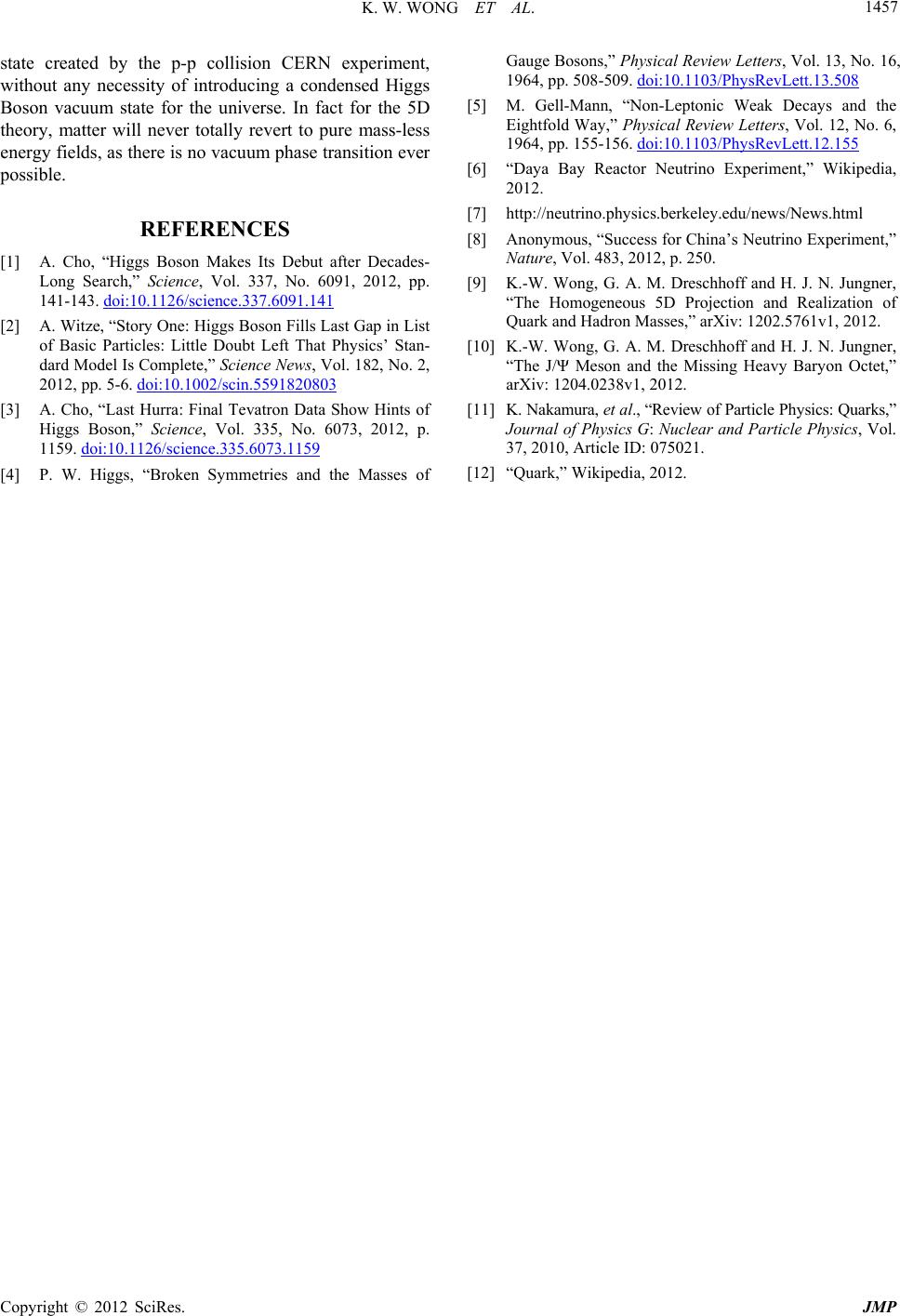 K. W. WONG ET AL. Copyright © 2012 SciRes. JMP 1457 state created by the p-p collision CERN experiment, without any necessity of introducing a condensed Higgs Boson vacuum state for the universe. In fact for the 5D theory, matter will never totally revert to pure mass-less energy fields, as there is no vacuum phase transition ever possible. REFERENCES [1] A. Cho, “Higgs Boson Makes Its Debut after Decades- Long Search,” Science, Vol. 337, No. 6091, 2012, pp. 141-143. doi:10.1126/science.337.6091.141 [2] A. Witze, “Story One: Higgs Boson Fills Last Gap in List of Basic Particles: Little Doubt Left That Physics’ Stan- dard Model Is Complete,” Science News, Vol. 182, No. 2, 2012, pp. 5-6. doi:10.1002/scin.5591820803 [3] A. Cho, “Last Hurra: Final Tevatron Data Show Hints of Higgs Boson,” Science, Vol. 335, No. 6073, 2012, p. 1159. doi:10.1126/science.335.6073.1159 [4] P. W. Higgs, “Broken Symmetries and the Masses of l. 13, No. 16, Gauge Bosons,” Physical Review Letters, Vo 1964, pp. 508-509. doi:10.1103/PhysRevLett.13.508 [5] M. Gell-Mann, “Non-Leptonic Weak Decays and the Eightfold Way,” Physical Review Letters, Vol. 12, No. 6, 1964, pp. 155-156. doi:10.1103/PhysRevLett.12.155 [6] “Daya Bay Reactor Neutrino Experiment,” Wikipedia, 2012. [7] http://neutrino.physics.berkeley.edu/news/News.html [8] Anonymous, “Success for China’s Neutrino Experiment,” Nature, Vol. 483, 2012, p. 250. [9] K.-W. Wong, G. A. M. Dreschhoff and H. J. N. Jungner, “The Homogeneous 5D Projection and Realization of g Heavy Baryon Octet,” . Quark and Hadron Masses,” arXiv: 1202.5761v1, 2012. [10] K.-W. Wong, G. A. M. Dreschhoff and H. J. N. Jungner, “The J/Ψ Meson and the Missin arXiv: 1204.0238v1, 2012. [11] K. Nakamura, et al., “Review of Particle Physics: Quarks,” Journal of Physics G: Nuclear and Particle Physics, Vol 37, 2010, Article ID: 075021. [12] “Quark,” Wikipedia, 2012.
|